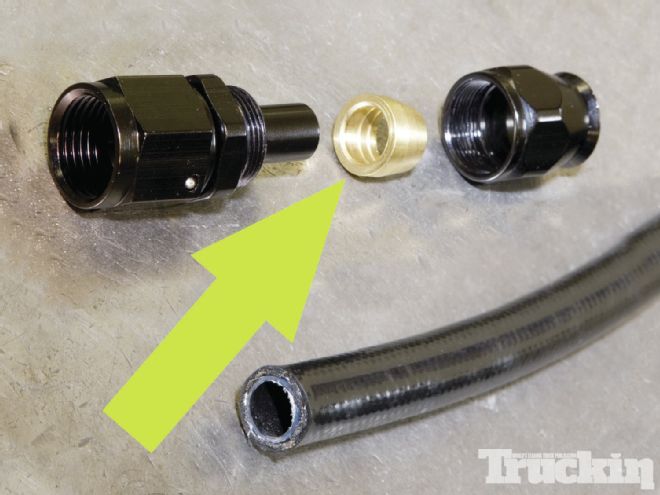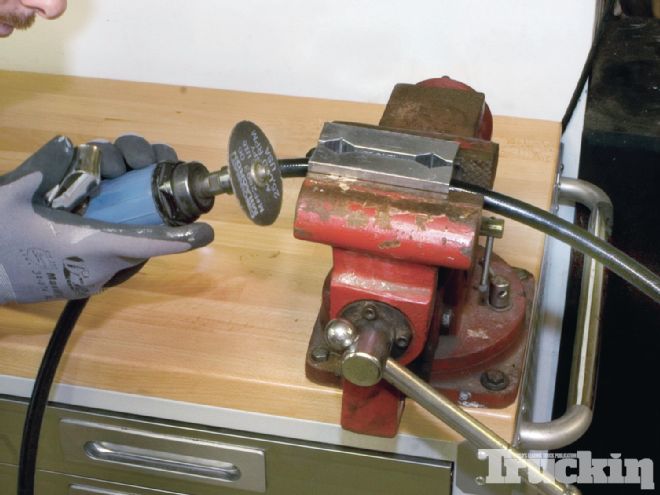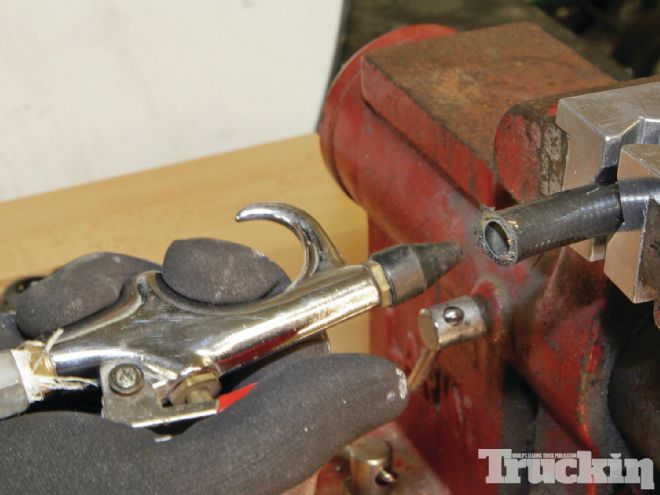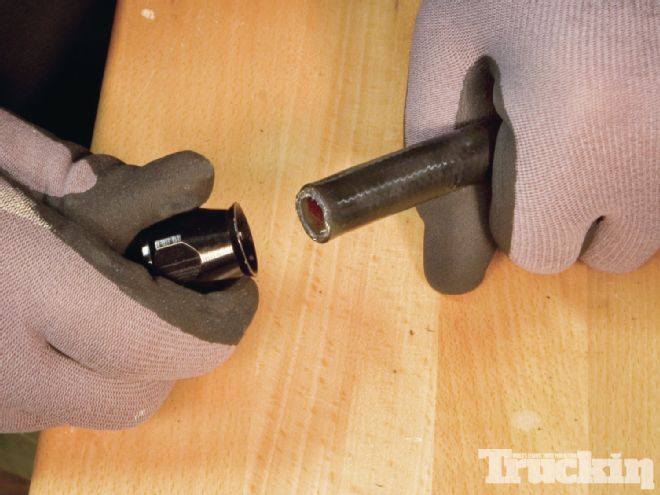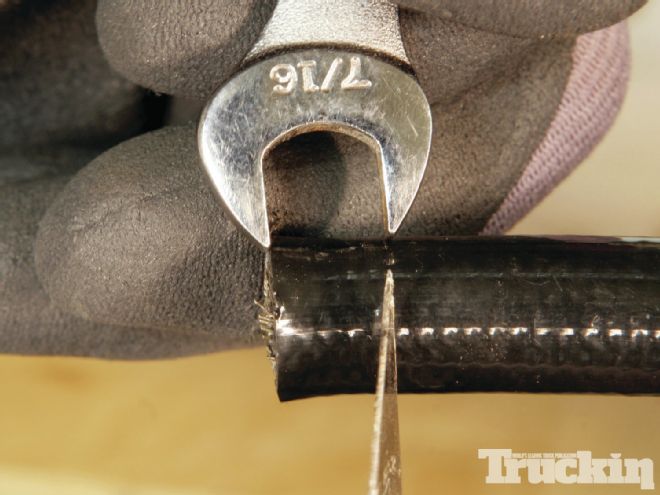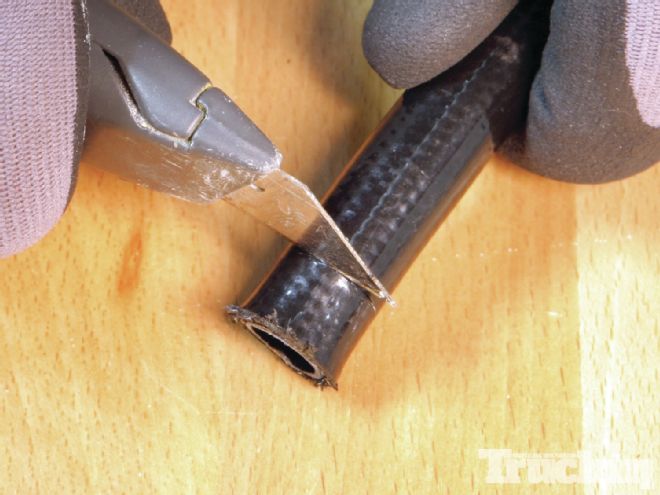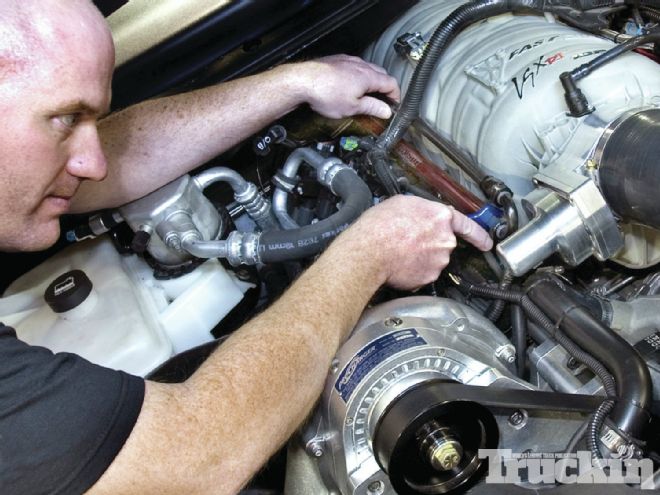
| the Smell Of Success fuel Line On Lsx Engine
Change often comes with compromise and that is certainly the case when it comes to todays gasoline. It is not the sweet-smelling, pseudo-solvent fuel we all grew up withwell, most of us anyway. Modern gasoline is an aggressive-smelling chemical with plenty of additives. It burns cleaner, which is great for performance and emissions, but its composition permeates rubber, including fuel hoses. In fact, it can actually seep through rubber hose, drying it out prematurely and causing it to become brittle, crack, weep and possibly fail.
It’s an increasingly common problem these days and one you may have noticed, as it manifests itself as the smell of leaking gas. Not surprisingly, that smell also brings the odor of concern for anyone with a higher-performance engine – and it seems to be a particular issue for engines with power adders or others with modifications that require fuel-system upgrades and likely incorporate rubber-core braided-steel hose. Typically, the smell is caused by the fuel “boiling” through the rubber hose as the vehicle sits in garage. Beyond the safety issues of having gasoline vapors in your garage, this smell is not appealing. Also, that smell is just an early warning that a rubber fuel hose is drying out and will eventually fail.
So, while you can’t change the gasoline that feeds your engine, you can make a change to the hoses that carry it, eliminating the problem and smell all together. The solution is swapping out the conventional rubber fuel hoses with PTFE-core hoses. PTFE is the abbreviation for PolyTetraFluoroEthylene, but you know it more by its common trade name, Teflon, DuPont’s trade name for their version of PTFE. PTFE hoses have been around for a long time, used mostly for brake and hydraulic fluid transfer applications. The big advancement in PTFE fuel hoses is that they now are available with a “conductive core” inside them, which is a carbon lining added during manufacturing that, when combined with the fittings that install on each end of a hose assembly, provides a path for any static charge in the line. If you are wondering where a static charge would come from in the fuel line, it’s a quirk of the PTFE material. When a non-conductive fluid, such as gasoline, diesel, ethanol, methanol or a similar product, passes through it at high velocities, stray electrons (static electricity) are generated. That’s obviously a condition you don’t want with gasoline, so the conductive core of the PTFE fuel hose eliminates the chance that the static charge will find a ground and flame-broil your truck like a Labor Day barbeque.

| Here is a close-up of the TechAFX BlackWrap PTFE AN hose with a TechAFX aluminum, black anodized fitting installed on the end. While installing a fitting on the BlackWrap is a little different than the way old-style rubber AN hose and fittings go together, it can still be performed pretty easily in your garage at home. However, you’ll need a sturdy vice.
Conductive-core PTFE lines are a specialty of Michigan-based TechAFX (techafx.com), which is who we turned to guide us through a tutorial on the subject and a demonstration of building new AN-type fuel lines and fittings for a ProCharger-blown, 404ci Chevy Trailblazer SS at Motor City Speed, in Walled Lake, Michigan. TechAFX is a leading developer of aftermarket PTFE products, manufactured not only to O.E. vehicle engineering standards, but military specifications. And, yes, PTFE hoses are more expensive than conventional rubber fuel hoses, but not prohibitively so. It’s definitely an affordable upgrade and one that you should only need to perform once on the life of your truck, while rubber hoses may need more than one replacement to keep the odor of leaking gas at bay.
The accompanying photos illustrate the basic steps in building a PTFE hose and fittings for use on that blown TrailBlazer SS at Motor City Speed, but they can also be applied to Ford, Dodge/Ram and import trucks. The basic procedure is universal and there are few tips and tricks to keep in mind:
To prevent the four-wheel flambé situation described previously, it is imperative that only conductive-core PTFE hose be used for fuel lines. That is easily determined, however, because the inside diameter of the hose is black. PTFE hose is too stiff for hose clamps. It won’t “crush” onto a fitting to create a good seal, like a conventional clamp. So, unique aluminum AN fittings (developed by TechAFX) must be used to secure the new hoses. Bend radius is not a problem with PTFE hoses, but PTFE is stiffer than rubber hose material, although it has a smaller outside diameter (the PTFE hose wall thickness is only about one-third that of rubber fuel hose). That means the new hose can definitely match the bend requirements of most fuel hose applications. Cutting PTFE chose is no different than cutting rubber hose, but AN fittings use a brass “olive” (or ferrule) that crushes to provide the seal at the fitting/hose mating point. Because most PTFE AN fittings are non-swivel, it’s difficult to create complete hose assemblies, but TechAFX has a semi-swivel fitting that can be rotated on the hose during assembly to make it easier to build an assembly at home. Although there are a few very-expensive, crimp-fitting PTFE AN hose/fitting products on the market, TechAFX is the only supplier we’ve found with aluminum fittings designed to work with the more common -6, -8 and -10-diameter hoses for do-it-yourself projects. A couple of other notes: TechAFX stainless steel wrapped, conductive core, PTFE hose called Blackwrap, which is what is shown in our photos. This hose features a black rubber coating that looks great, minimizes abrasion issues and aids in hose assembly. And like the basic PTFE hoses, it is offered in -6, -8 and -10 sizes. Also, one of the longstanding problems with PTFE fittings and hose has been non-swivel designs, which made “clocking” the fittings on the hose very difficult – and fitting the hose to the engine under the hood very frustrating. Our project features a semi-swivel AN fitting design that pretty much solves the problem, but some trial-and-error test-fitting is still required.
We found the project to be very straightforward and easy. And after building the hoses, it was a simple matter of swapping them for the lines on the truck, although that’s a project that requires careful relief of the pressure in the fuel system. It’s best to let your truck sit overnight before attempting it and even then, wear eye protection and make sure your car is clear of any source that could ignite spilled fuel. Your hands will smell like gas for the rest of the day, but after that, your truck won’t.
 | the Smell Of Success fuel Line On Lsx Engine
Change often comes with compromise and that is certainly the case when it comes to todays gasoline. It is not the sweet-smelling, pseudo-solvent fuel we all grew up withwell, most of us anyway. Modern gasoline is an aggressive-smelling chemical with plenty of additives. It burns cleaner, which is great for performance and emissions, but its composition permeates rubber, including fuel hoses. In fact, it can actually seep through rubber hose, drying it out prematurely and causing it to become brittle, crack, weep and possibly fail.
It’s an increasingly common problem these days and one you may have noticed, as it manifests itself as the smell of leaking gas. Not surprisingly, that smell also brings the odor of concern for anyone with a higher-performance engine – and it seems to be a particular issue for engines with power adders or others with modifications that require fuel-system upgrades and likely incorporate rubber-core braided-steel hose. Typically, the smell is caused by the fuel “boiling” through the rubber hose as the vehicle sits in garage. Beyond the safety issues of having gasoline vapors in your garage, this smell is not appealing. Also, that smell is just an early warning that a rubber fuel hose is drying out and will eventually fail.
So, while you can’t change the gasoline that feeds your engine, you can make a change to the hoses that carry it, eliminating the problem and smell all together. The solution is swapping out the conventional rubber fuel hoses with PTFE-core hoses. PTFE is the abbreviation for PolyTetraFluoroEthylene, but you know it more by its common trade name, Teflon, DuPont’s trade name for their version of PTFE. PTFE hoses have been around for a long time, used mostly for brake and hydraulic fluid transfer applications. The big advancement in PTFE fuel hoses is that they now are available with a “conductive core” inside them, which is a carbon lining added during manufacturing that, when combined with the fittings that install on each end of a hose assembly, provides a path for any static charge in the line. If you are wondering where a static charge would come from in the fuel line, it’s a quirk of the PTFE material. When a non-conductive fluid, such as gasoline, diesel, ethanol, methanol or a similar product, passes through it at high velocities, stray electrons (static electricity) are generated. That’s obviously a condition you don’t want with gasoline, so the conductive core of the PTFE fuel hose eliminates the chance that the static charge will find a ground and flame-broil your truck like a Labor Day barbeque.
| the Smell Of Success fuel Line On Lsx Engine
Change often comes with compromise and that is certainly the case when it comes to todays gasoline. It is not the sweet-smelling, pseudo-solvent fuel we all grew up withwell, most of us anyway. Modern gasoline is an aggressive-smelling chemical with plenty of additives. It burns cleaner, which is great for performance and emissions, but its composition permeates rubber, including fuel hoses. In fact, it can actually seep through rubber hose, drying it out prematurely and causing it to become brittle, crack, weep and possibly fail.
It’s an increasingly common problem these days and one you may have noticed, as it manifests itself as the smell of leaking gas. Not surprisingly, that smell also brings the odor of concern for anyone with a higher-performance engine – and it seems to be a particular issue for engines with power adders or others with modifications that require fuel-system upgrades and likely incorporate rubber-core braided-steel hose. Typically, the smell is caused by the fuel “boiling” through the rubber hose as the vehicle sits in garage. Beyond the safety issues of having gasoline vapors in your garage, this smell is not appealing. Also, that smell is just an early warning that a rubber fuel hose is drying out and will eventually fail.
So, while you can’t change the gasoline that feeds your engine, you can make a change to the hoses that carry it, eliminating the problem and smell all together. The solution is swapping out the conventional rubber fuel hoses with PTFE-core hoses. PTFE is the abbreviation for PolyTetraFluoroEthylene, but you know it more by its common trade name, Teflon, DuPont’s trade name for their version of PTFE. PTFE hoses have been around for a long time, used mostly for brake and hydraulic fluid transfer applications. The big advancement in PTFE fuel hoses is that they now are available with a “conductive core” inside them, which is a carbon lining added during manufacturing that, when combined with the fittings that install on each end of a hose assembly, provides a path for any static charge in the line. If you are wondering where a static charge would come from in the fuel line, it’s a quirk of the PTFE material. When a non-conductive fluid, such as gasoline, diesel, ethanol, methanol or a similar product, passes through it at high velocities, stray electrons (static electricity) are generated. That’s obviously a condition you don’t want with gasoline, so the conductive core of the PTFE fuel hose eliminates the chance that the static charge will find a ground and flame-broil your truck like a Labor Day barbeque.
